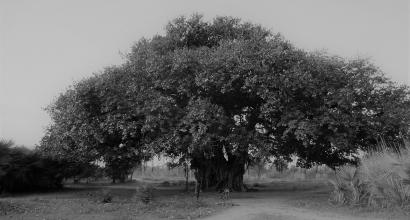Badami Chalukyas
Another great luminary whom we must consider alongside Harshavardhana is Immadi Pulakeshi (Pulakeshi II). He belongs to the Badami Chalukyas. Harshavardhana hailed from a
Vaiśya clan, Pulakeshi from a
Śūdra clan. Basically the Chalukyas came from an agricultural background; they were originally a farming community. In the first
sarga (canto) of Bilhaṇa’s
Vikramāṅkadevacaritam, we find a story about the origin of the Chalukyas written in a
paurāṇika (mythological) style. The story is as follows: Once, the
devas went to Brahmā and said, “Danger has befallen the earth. A great
Kṣatriya king, who will abide by
dharma, must be born!” At that time, Brahmā, who was offering his evening prayers, had cupped his hands for the ‘
sandhyāñjalī’ and from those cupped hands—
‘culuka’—itself he created ‘
Cālukya,’ a great hero. From him, the Chalukya dynasty was born. According to modern-day scholars, ‘
cālukya’ is not a Sanskrit word. From ‘
culuka’ we will get ‘
caulukya’ and not ‘
cālukya’ (as per grammar). Therefore, it originates from ‘
salike.’ In other words, the origin is from people who held the ‘
salike’—shovel—and worked in the fields. A horrifying delusion has engulfed our consciousness. As usual, it is the fabrication of the communists. As per their concoction, ‘
Brāhmaṇas and
Kṣatriyas jointly oppressed everyone else.’ In reality, if any such oppression took place, it was by the
Śūdras. Ninety percent of Indian kings were
Śūdras. We can give several examples for this, including: Mauryas, Yadavas, Paramaras, Chandelas, Hoysalas, Sevunas, Chalukyas, Cholas, Cheras, Rashtrakutas, Sangamas, Salwas, Tuluvas, Araridis, Rathores, Solankis, Bhonsles, and Chauhans. Starting from the Mauryas, in a period of close to two thousand and five hundred years, we find close to two hundred and fifty such
rāja-vaṃśas (royal lineages). Even today, in Karnataka, the most powerful people are the Lingayatas and Vokkaligas; in Andhra, it is the Kammas, Kapus, and Reddys; and we hardly need to speak about the situation in Tamil Nadu. The influence of the Patels in Gujarat is well-known as is the inordinate power wielded by the Yadavs in Bihar. In this manner, even today, across India, we find that the situation continues. Thus we must keep aside our prejudices and see through the clear lens of truth. A resident of a glass house must not attempt to throw stones at someone living in a house with tiled roof. In our country, the prime movers of the caste wars are those who claim to have transcended caste.
The Chalukya dynasty has given us many great warrior-kings. There is a famous saying, ‘
vīrabhojyā vasundharā’ (The brave ones shall enjoy the earth). A
Kṣatriya is determined not by birth but by qualities and deeds alone. A
Kṣatriya by birth only has the name, and by mere nomenclature one cannot achieve the desired quality.
Immadi Pulakeshi
Pulakeshi I was an important Chalukya king. His son was Kirtivarma I, who was the father of Immadi Pulakeshi (Pulakeshi II). The famous king Mangalesha was Kirtivarma’s younger brother. He too was a brave warrior. In our historical stories and novels, everyone except the hero is portrayed as evil. But reality is never so black and white; there are several grey shades. Mangalesha was courageous and had titles such as ‘Satyāśraya’ [refuge of truth] and ‘Raṇavikrama’ [battlefield hero]. He had waged and won several wars. In Badami, there is a famous cave called the Viṣṇuguhā. He is the one who had it built. The Chalukyas encouraged and supported both
Śaivas and
Vaiṣṇavas. Mangalesha’s elder brother’s son was Pulakeshi II. He had many younger brothers, the foremost among whom was ‘Kubja’ Vishnuvardhana (‘
kubja’ means hump-backed; the reason for such a title was his physical deformity). Pulakeshi II grew up facing several challenges and obstacles. A few people hazard a guess that he was educated at the
gurupīṭha in Aihole (Ayyahoḻe). Ravikirti was his classmate and good friend. What we know about Pulakeshi today is primarily from an inscription on the wall of a temple situated on a hill in Aihole.
[1]
When Pulakeshi obtained the love and respect of his people by his valour and goodness of character, his uncle had to let him rule the kingdom. At that point, Mangalesha opposed it with great force and several strategies. Anyone who has ascended a seat of power will find it difficult to relinquish that power. Soon the brothers fought against each other. For a short while, Pulakeshi seems to have left the kingdom, perhaps to strengthen himself. Since the kingdom lacked a great warrior of the calibre of Pulakeshi, enemies began causing trouble. Therefore he had to return to the throne, uncontested.
[2]
Pulakeshi defeated several of his enemies in the coastal region. He was victorious against quite a few of the Rashtrakutas, vanquished the Shatavahanas, and even subdued the southern king Mahendravarma Pallava. Not only did he march all the way down to Kanchipuram, his suzerainty included Kanyakumari. After bringing the whole of South India under his control, Pulakeshi faced in battle Harshavardhana, who had marched all the way to the banks of the Narmada. Harshavardhana, the
uttarāpatha-parameśvara (the great lord of the Northern realm), desired to become the emperor of the whole of India and had to encounter Pulakeshi, the
dakṣiṇāpatha-parameśvara (the great lord of the Southern realm) on the banks of Narmada. In that war, Pulakeshi easily defeated Harshavardhana. But both of them being cultured kings, they worked out a sensible truce. The later cultural ramifications of this truce are noteworthy. The
gadya-cakravarti (emperor of prose) and
mahākavi Bāṇabhaṭṭa was in the court of Harsha and composed the
Harṣacarita. The
maṅgala-śloka (benedictory verse) of the
Harṣacarita—नमस्तुङ्गशिरश्चुम्बिचन्द्रचामरचारवे। त्रैलोक्यनगरारम्भमूलस्तम्भाय शम्भवे॥—later became the
maṅgala-śloka for several Chalukya inscriptions. In fact, in the inscriptions of other dynasties of Karnataka too we find the use of this benedictory verse. Politically Harshavardhana lost but culturally he won. This Chalukyas might not have accepted Harshavardhana’s sovereignty but they readily accepted the benedictory verse from a poem that was written about him, in praise of his achievements. The reason for this is not merely the excellent quality of Bāṇa’s verse but also the refined taste and connoisseurship of Pulakeshi in the areas of literature, music, and other
śāstras. Pulakeshi was truly a king who brought joy to his people.
The renowned Telugu novelist Nori Narasimha Shastri has written a remarkable novel on the life of ‘Kavisārvabhauma’ (lit. ‘emperor of poetry’) Srinatha titled ‘
Kavisārvabhaumuḍu.’ A lesser-known royal family of Andhra is the Kondavidu. When the king of that family, Pedakomati Vemareddy began losing all his wealth as well as the boundaries of his kingdom, the Vijayanagara Empire was in its ascent. Praudadevaraya II was the king of Vijayanagara then. The poet in his court who had been honoured with the title ’Kavisārvabhauma’ was the famous Arunagirinatha Dindimabhattaraka. King Vemareddy felt that while winning a political battle against Vijayanagara might not be possible, if Kavisārvabhauma Srinatha of his court were to defeat KavisārvabhaumaDindimabhattaraka, he would get the solace of defeating Vijayanagara culturally via a scholarly path. With these thoughts, he sent Srinatha to the Vijayanagara king. Srinatha kept as his primary focus
Alaṅkāraśāstra (referred to as
Udbhaṭaśāstra in the poem of Srinatha; in those days
alaṅkāraśāstra was also called
udbhaṭaśāstra since Udbhaṭa was a famous
ālaṅkārika of those days) and defeated Dindimabhattaraka in a scholarly debate; in the court of King Devaraya, he was made to sit in the center of a pearl pavilion and a
kanakābhiṣekam (lit. 'showering with gold') was performed on him. Nori Narasimha Shastri has beautifully portrayed this in his novel. This is a positive way of taking revenge. When a physical victory is unattainable, instead of trying to employ cunning and deceit, it is better to intellectually subdue the other. The Greeks were sadly vanquished by Roman forces. However, the Greek culture left an indelible mark on every aspect of the Roman civilization and tradition.
The greatest period of the Roman Empire was the reign of Augustus Caesar. Virgil, who was his court poet, composed his work
Aeneid by combining the two Greek epics,
Iliad and
Odyssey (if not in quality, he wanted to at least capture the story of both the epics in his work). The first half of the
Aeneid corresponds to the
Odyssey and the second half to the
Iliad. Aeneas is a hero who hails from Troy, an enemy of the Greeks. Virgil’s conception is that Aeneas comes to Italy and becomes the progenitor of the Roman civilization through his children. This kind of connectivity between the two cultures happened in a noble manner. It avoided bloodshed. The relations between the two nations improved.
Similarly, we find the magnanimity of Pulakeshi II remarkable; the manner in which Harshavardhana accepted defeat is also praiseworthy. However, for such a thing to take place, both parties must be culturally refined and virtuous in character. When we see Harsha’s subsequent decline, it seems like it was his good fortune that he faced an enemy like Pulakeshi. Such heart-warming treaties are beyond imagination with the barbaric Islamic and Christian forces.
To be continued...
Translated by Sandeep Balakrishna and Hari Ravikumar from the original Kannada.
Footnotes
[1] It is famous as the Aihole inscription. It is effulgent and beautiful epigraph-poetry in Sanskrit. There are a few inscriptions that are of both poetic and historical value. For example, the Samudragupta
praśasti in Prayag written by Hariṣeṇa, Vatsabhaṭṭi’s
praśasti at Mandeshwara, Skandagupta
praśasti at Junargadh, and the Rudradaman inscription. The Aihole inscription falls in this category. In this inscription, Ravikirti gives us a hint of the period of Kālidāsa and Bhāravi; we come to know that Kālidāsa flourished in an earlier period as compared to Bhāravi:
येनायोजि न वेश्म
स्थिरमर्थविधौ विवेकिना जिनवेश्म।
स विजयतां रविकीर्तिः
कविताश्रितकालिदासभारवीकीर्तिः॥
(Aihole Inscription, Poem 37)
For those interested in prosody and poetic meters, here’s a piece of trivia. It is in the Aihole inscription that we first find the use of the meter Mattebhavikrīḍita in Sanskrit. It is seen in poem 18: “वरदातुङ्गतरङ्गरङ्ग...”
[2] There has been a lot of discussion about the name ‘
pulakeśi.’ Is it ‘
pulakeśi’ or ‘
pulikeśi ’ or ‘
polekeśi ’? The Aihole inscription has ‘
polikeśi.’ This evidence is the strongest. I had asked the well-known scholar Dr. T V Venkatachala Shastri about this. He told me that he was planning to write a short paper on this topic. Several years later I asked him if he wrote that paper. He replied in the negative; he said he was still unsure of it and hadn’t made up his mind. How to write a paper without conclusive proof? If I were to hazard a guess, the meaning could be ‘
polemaneya keśi’ meaning ‘Krishna (
Keśi) in the labour room (
prasūtikāgṛha).’ Alternatively, it could refer to one experiencing horripilation –
pulakita keśa. Is it a Sanskrit word or is it a Kannada word – even that is unclear. Let that be; whatever be the meaning of his name, his achievements make him great and memorable.















































